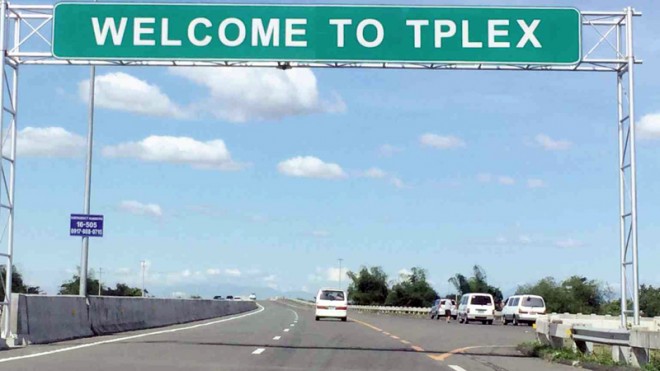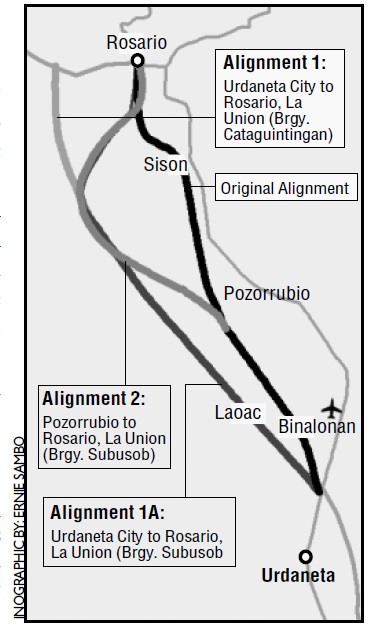TPLEx rerouting squabble sizzles

THE TARLAC-PANGASINAN-LA UNION EXPRESSWAY (TPLEx) is expected to shorten travel time to Baguio City and the Ilocos provinces once it is completed in 2016. CONTRIBUTED PHOTO
Tribal leader Inocencio Carganilla has been worried since last week when it was reported that many farmers in his hometown of Sison in Pangasinan province would lose their farms once the government builds the Tarlac-Pangasinan-La Union Expressway (TPLEx) through their properties.
“The farmers belong to the Bago, Ibaloy and Applai communities. Many of them own only about half a hectare of land each. Farming is their only source of livelihood,” said Carganilla, president of Sison’s tribal federation.
TPLEx, an 88.85-km expressway being built to link Tarlac City to Rosario town in La Union province, has become familiar to the public because of the Christmas holiday gridlock that spoiled the vacation of many people traveling through northbound expressways to Baguio City and other North Luzon provinces.
Connected to the Subic-Clark-Tarlac Expressway (SCTEx), it was designed to shorten travel time from Metro Manila to Baguio from six hours to about four hours. It is being built by the Private Infra Development Corp. (PIDC), a consortium owned by the San Miguel Corp., under a build-operate-transfer contract.
MNR to Urdaneta
According to the Department of Public Works and Highways’ (DPWH) website (dpwh.gov.ph), TPLEx crosses the Manila North Road (MNR) in Urdaneta City, cuts through the towns of Laoac, Binalonan, Pozorrubio and Sison in Pangasinan, and ends in Rosario.
Last week, work began for the last section of the expressway, which is a 25.83-km stretch from Urdaneta to Barangay Saitan in Rosario, the entry point to Baguio via Kennon Road.
“They cannot just build [through Sison to complete TPLEx] and destroy our farms without our consent. These are ancestral lands,” said Carganilla. The Indigenous Peoples’ Rights Act (Republic Act No. 8371) requires developers of ancestral lands to secure the free, prior and informed consent of indigenous peoples (IP) communities.

MAP SHOWS the original alignment of the TPLEx exit (line in black) and the proposed alignments submitted to Neda. MAP COURTESY OF NEDA
Sison has the biggest IP population among 12 Pangasinan towns hosting tribal communities.
Sison Mayor Mina Joy Pangasinan said TPLEx will pass through the only productive areas of the town. In 2010, the town council passed a resolution asking DPWH to realign TPLEx because it would damage a vast area of real properties, agricultural and residential lots and buildings.
The town councils of Pozorrubio and Rosario and the Pangasinan provincial board followed suit with similar resolutions in 2011 and 2012.
New route
Their concerns have been raised by former Pangasinan Rep. Mark Cojuangco, who has proposed a new route to the Rosario interchange.
Saying he saw the problem in 2009, Cojuangco urged the DPWH to move TPLEx to the west, away from the MNR. This way TPLEx would pass through undeveloped lands in the Sison villages of Bantay Insik and Tara-tara, skirting Sta. Cruz village in San Jacinto town and Innalog village in San Fabian town, before it links up to the final TPLEx interchange in Rosario.
This route is about 5 km away from the original exit but it is scenic and would reduce the cost of buying road-right-of-way properties because the areas are sparsely populated, he said, adding that the agricultural areas are rain-fed and are on slopes.
Cojuangco became vocal about his proposal after Benguet Rep. Ronald Cosalan, chair of the House committee on public works, and Baguio Rep. Nicasio Aliping Jr., asked the Baguio city council and the Benguet provincial board on Jan. 12 to pass resolutions demanding that the government complete TPLEx as it was originally designed.
Public Works Secretary Rogelio Singson had forwarded Cojuangco’s proposal to the TPLEx concessionaire, saying its contract allows changes to the project design this late in the stage of the project, “but subject to the approval of the DPWH.”
Cosalan said Cojuangco’s proposed route would extend the road, defeating the purpose of reducing travel time.
Economic benefits
A shorter TPLEx that links directly to Baguio has economic benefits, he said. Most of Metro Manila’s salad vegetables are supplied by Benguet farmers who deliver their produce to the metropolis daily.
The extended highway affects these shipments because a longer route will result in higher toll fees, according to the Cordillera Regional Development Council (RDC) and the region’s project monitoring committee.
The RDC passed Resolution No. 1 last week, supporting the TPLEx’s original design. It was addressed to the DPWH and the board of the National Economic and Development Authority (Neda).
Aside from Cojuangco’s proposal, the Neda board and DPWH have been studying two other rerouting proposals, which were evaluated by the Filipinas Dravo Corp.
Cosalan said an extended TPLEx would cost the government an additional P1 billion, which Cojuangco disputed.
“Let’s say it’s true that it will cost P1 billion more. For me, it’s not an expense; it’s an investment in [the] shortening of the route for the next phase [of another expressway to the Ilocos and Cagayan Valley regions] … It’s not P1 billion that accomplishes nothing. It’s P1 billion to save 5 km for all points going north outside of Baguio,” Cojuangco said.
Sound proposal
Baguio Mayor Mauricio Domogan said Cojuangco’s proposal was sound, given the potential savings in road-right-of-way purchases, as well as the threat of potential delays if some landowners block the last stage of the TPLEx construction. (See related story on Page A16.)
The Christmas holiday gridlock was another compelling reason to reroute the TPLEx exit, Domogan said.
Cojuangco said the traffic jam that trapped northbound travelers in December was due to the congestion in Rosario.
“Baguio is not the only destination. The destination is the north. Why would you want all vehicles there [at Barangay Saitan in Rosario]?” he said.
He said the proposed exit allows vehicles to branch away to a route up to Baguio and another route going to the Ilocos provinces. With a report from Vincent Cabreza